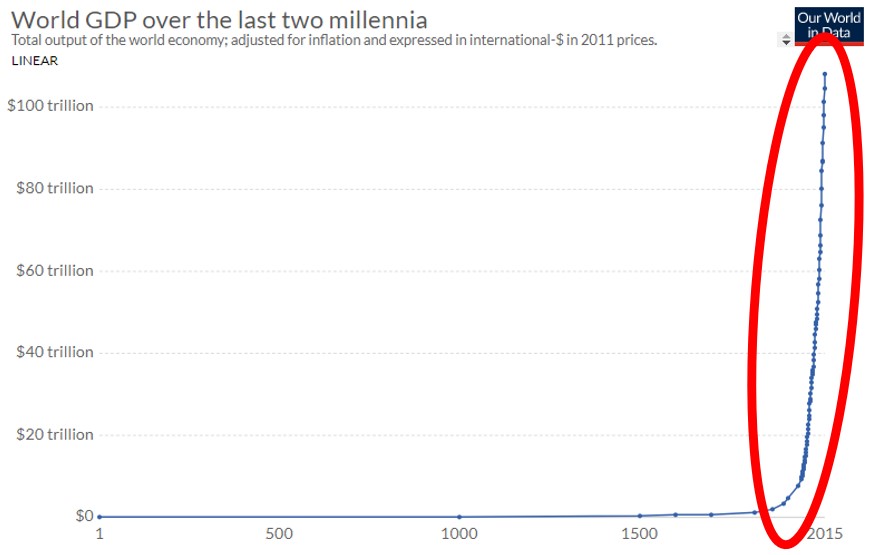The nature of work is changing. Two main forces are driving this change: digitalisation and globalisation.
With digitalisation, we’re seeing more and more businesses and jobs become computer-based…or more specifically, internet-based.
And since the internet is global, that trend has acted as an accelerant for globalisation…where distance becomes essentially irrelevant.

These two things — digitalisation and globalisation — are responsible for the insane economic development around the world over the past 30 years…the section circled in red below:
Now this development has entered a new phase — the birth of remote working.
Sure, the idea has been around for centuries, but only now — with the advent of globalisation and digitalisation — is the true potential of remote work being realised.
We’re seeing over half of employees around the world working remotely at least once a month. Almost a fifth of workers work remotely full time.
Those employees are significantly more productive, more engaged, and stay on for longer. Roughly a 25% improvement in each of those categories.
Companies are attracting talent they’d never otherwise have access to…they’re saving millions on overhead…they’re squeezing far more productivity out of each employee in far less time.
But not all companies are keen.
In fact, about half of global employers don’t allow remote work at all. Why is that?
Three reasons why some are fighting remote work
Firstly, trust. Many employers don’t trust their employees working from home. They picture them floating around in their backyard pool, mojito in hand, phone turned off, and Jimmy Buffett booming from the sound system.
Of course, some folks would do that (Doesn’t sound too terrible to me).
But the data and research points to most employees becoming even more productive when they start working from home.
A Stanford professor worked with a large business to see what happens when they gave the work-from-home option to employees. He figured there’d be pros and cons…and they’d mostly cancel each other out and the result would be insignificant.
Instead, what he found was an incredible boost across the board.
The increase in productivity was equivalent to each worker putting in another full day’s work each week. Attrition was cut in half. Sick days and time off dropped. Huge savings in rent, equipment, and maintenance.
(You can watch his Ted Talk here.)
But without trust, an employer’s paranoia will never let this kind of policy crystallise. [openx slug=inpost]
Secondly, tradition. Most of the folks heading up big business today grew up before the Internet age.
The closest thing to remote work they knew were travelling salesmen. They see structure in offices, with neatly lined rows of cubicles. Hallways and offices. Break rooms and a front desk.
That’s what mature businesses look like. It’s where successful businesspeople work. Anything else is buffoonery.
I get it. In business school, I remember reading all about the science of management…about optimising work environments to get people to be collaborative and productive. And never did any of the textbooks mention having people work from home. Every theory was based within the traditional office environment.
But that’s changing…and most of those theories are being replaced with new and innovative remote solutions backed by research and data. Today’s managers are thinking outside of the box…or more specifically, outside of the cubicle.
Thirdly, collaboration. Called by many names — like synergy and teamwork — most managers understand that collaboration is the key to a growing workforce. And what does peak collaboration look like?
Brainstorming meetings around a big table. Essentially, this:

Is that what you pictured?
Based on my experience, that’s what most managers like to see when they call for collaboration. Order in pizza, roll up your sleeves, throw in a whiteboard and whew! That’s what I call synergy.
And based on that belief, many managers refuse to consider remote work.
But the truth is, there are so many other ways of collaborating and communicating with a team today. Phone, email, instant message, videoconference, text, etc.
And in many cases, people would prefer these channels over a dedicated in-person meeting period. Especially for the younger ‘don’t call, just text’ generation. I certainly would.
In fact, I’m quite comfortable with the remote work set-up. I did it for nearly a year while living in Anchorage, Alaska and working with a team based in Washington DC. We’d instant-message via Slack throughout the day. Videoconference via Skype for discussions. Email via Outlook when including those outside the team. Phone calls for anything else.
We probably communicated more when I was remote than before when we shared an office.
And when one or two of us would fly off for some overseas work trip, our collaborative workflow wouldn’t be disrupted in the least. Business as usual.
We could be together or spread out to opposite corners of the globe and our collaborative machine would just keep on humming.
No conference room necessary.
And that’s likely what the successful corporations of the future will look like. They’ll be leaner, more dynamic, more global and more productive. In their dust, all the old guard who thought proximity was the key to success.
Big prospects for New Zealand
Based on this picture, the outlook for New Zealand looks bright! For too long, our tiny islands in the South Pacific have been locked out of the global marketplace. Distance being the main obstacle in the road to progress. We’re just too darn far away from all the excitement.
But with digitalisation and globalisation on the rise, that obstacle is disappearing. Kiwis won’t need to move overseas to hunt for opportunities; they’ll be strong candidates as long as they have a dependable Internet connection.
Plus, that works on the immigration side too. Can you see a wave of white-collar workers leaving their dreary flats in London to enjoy the sunny South Pacific, all while securely keeping their job?
It also means a shift in what offices look like. Perhaps closer to the co-working model, where lots of people from different businesses share a workspace. More individual, less corporate.
Maybe it means a lot more people spending full days in cafés, typing away on their laptops.
Or maybe it means the end of the two-piece suit and the start of business pyjamas.
How do you see it panning out? Let me know at [email protected]
Best,
Taylor Kee
Editor, Money Morning New Zealand





Taylor Kee is the lead Editor at Money Morning NZ. With a background in the financial publishing industry, Taylor knows how simple, yet difficult investing can be. He has worked with a range of assets classes, and with some of the world’s most thought-provoking financial writers, including Bill Bonner, Dan Denning, Doug Casey, and more. But he’s found his niche in macroeconomics and the excitement of technology investments. And Taylor is looking forward to the opportunity to share his thoughts on where New Zealand’s economy is going next and the opportunities it presents. Taylor shares these ideas with Money Morning NZ readers each day.